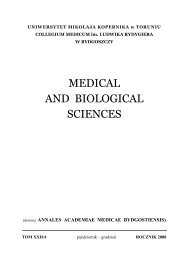Medical and Biological Sciences XXVI/2 - Collegium Medicum ...
Medical and Biological Sciences XXVI/2 - Collegium Medicum ...
Medical and Biological Sciences XXVI/2 - Collegium Medicum ...
You also want an ePaper? Increase the reach of your titles
YUMPU automatically turns print PDFs into web optimized ePapers that Google loves.
6<br />
Julia Feit et. al.<br />
Badanie przeprowadzono dwukrotnie: przed podaniem oraz<br />
około 1,5 godziny po podaniu leczniczej dawki metadonu.<br />
Wykonano Test Łączenia Punktów Reitana A. Arkusz<br />
testowy umieszczano na tablecie graficznym. W obu<br />
częściach testu zmierzono czas wykonania.<br />
W y n i k i . Stwierdzono, że średni czas wykonania<br />
testu TMT A przed podaniem metadonu u osób HIV(-) jest<br />
istotnie statycznie mniejszy niż u osób HIV(+). Natomiast po<br />
podaniu metadonu szybkość psychomotoryczna mierzona za<br />
pomocą Testu Łączenia Punktów TMT A nie jest istotna<br />
statystycznie u osób HIV(-) leczonych w programie<br />
substytucyjnym w porównaniu z osobami HIV(+). Osoby<br />
z grupy HIV (+) istotnie statystycznie szybciej wykonują test<br />
TMTA po podaniu pojedynczej dawki metadonu.<br />
Wnioski. Przyjęcie leczniczej dawki metadonu<br />
przez osoby zakażone wirusem HIV może mieć wpływ na<br />
zwiększenie sprawności psychomotorycznej. Wchodzenie<br />
leków antyretrowirusowych w interakcje farmakokinetyczne<br />
z metadonem może prowadzić do zmiany stężeń metadonu<br />
w ustroju i tym samym powodować zmiany w regulacji<br />
czynności psychomotorycznych.<br />
Key words: opiates, methadone, TMT A, HIV<br />
Słowa kluczowe: opioidy, metadon, TMT A, HIV<br />
INTRODUCTION<br />
Addiction to opioids is one of the strongest forms<br />
of addiction [1, 2]. Using opioids is connected with<br />
adaptive changes in the nervous system [3, 4]. Opioids<br />
affect cerebral neurotransmitters which transmit<br />
information among nerve cells. [5] Psychoactive<br />
substances can cause a release of a bigger or smaller<br />
amount of neurotransmitters into the synaptic cleft or<br />
inhibit the return transport or block its action [6]. Most<br />
of the dysfunctions <strong>and</strong> deregulations associated with<br />
the intake of opioids affect the brain reward system,<br />
which is probably responsible for the homeostasis of<br />
behavior [7]. It was proven that addiction is linked to<br />
disturbances not only in the reward system, but also in<br />
other major functional systems of the brain [8]. In<br />
particular, it relates to the system associated with the<br />
regulation of cognitive <strong>and</strong> emotional functions [8].<br />
Structural <strong>and</strong> functional changes in these structures<br />
are associated with the development of dependence to<br />
psychoactive compounds [8]. Morphological <strong>and</strong><br />
functional changes in the striatum, especially in the<br />
ventral striatum (<strong>and</strong> its main structure - nucleus<br />
accumbens), have been found in addicted individuals.<br />
It is the central structure of the limbic system <strong>and</strong> the<br />
reward system. According to the current knowledge, a<br />
cortico-subcortical loop is important in the processing<br />
of sensory (visual <strong>and</strong> auditory perception), cognitive<br />
(attention, executive functions, visual <strong>and</strong> auditory<br />
memory, spatial memory), emotional (mood) <strong>and</strong><br />
motor stimuli (extraocular movements, other skeletal<br />
muscle movements, such as upper limb muscles) [9,<br />
10, 11].<br />
Methadone is a synthetic opioid used in the<br />
substitution therapy of opioid addicts. Substitution<br />
treatment is the most effective method of treatment in<br />
this type of addiction. It lowers the risk of transmitting<br />
viruses: human immunodeficiency virus, hepatitis C<br />
virus, hepatitis B virus (HIV, HCV, HBV) <strong>and</strong> other<br />
infectious agents causing blood-borne diseases, thus<br />
reducing the mortality rate among drug addicts [12].<br />
Substitution therapy is the administration of a<br />
substitute agent [15]. Blockage of opioid receptors<br />
prevents mental <strong>and</strong> somatic symptoms of withdrawal<br />
state. The purpose of the therapy is delivering a<br />
controlled dose of a substitute agent, which will enable<br />
normal functioning, rebuilding, preserving health <strong>and</strong><br />
reducing or eliminating criminal behaviours [16].<br />
Alterations of the functioning of cortico-subcortical<br />
loops occur in patients infected with HIV which is a<br />
neurotropic virus. Features of subcortical stupor are<br />
found [17]. As a result of the activity of HIV most<br />
likely a damage of the striatum takes place.<br />
Psychomotor (oculomotor, upper limb movements)<br />
disturbances are the expected effect of the HIV virus.<br />
Additionally, emotional (which can be measured by<br />
changes in the functioning of the autonomic nervous<br />
system) <strong>and</strong> cognitive (disturbances in processing of<br />
information from the external <strong>and</strong> internal<br />
environment) impairments are seen [10, 11].<br />
In order to assess the impact of a therapeutic dose<br />
of methadone on psychomotor performance of HIV(+)<br />
subjects <strong>and</strong> HIV(-) subjects treated with the<br />
substitution therapy, a graphomotor test was used. The<br />
time of test completion was measured in subjects from<br />
both groups.<br />
MATERIAL AND METHODS<br />
The study was conducted in the group of 73<br />
participants of substitution program addicted to opioids<br />
<strong>and</strong> included 32 HIV(-) <strong>and</strong> 41 HIV(+) subjects.<br />
Twenty eight women <strong>and</strong> 45 men, participating in<br />
methadone substitution program for an average of 53

















